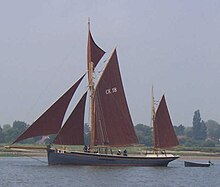Smack (ship)
This article needs additional citations for verification. (April 2019) |

Brooklyn Museum
).A smack was a
.Large numbers of smacks operated in fleets from ports in the UK such as
red ochre colour, which made them a picturesque sight in large numbers.[1]
Smacks were often rebuilt into steam boats in the 1950s.
Smacks were developed to transport live lobsters during the late 1700s. They were designed to allow seawater to circulate in a tank with holes in it. [2]
Military use
Smacks were used in British coastal waters during World War I as
Q ships. Actions involving smacks include the action of 15 August 1917, when the armed smacks Nelson and Ethel & Millie engaged a German U-boat in the North Sea. During this action the Nelson was sunk and its skipper, Thomas Crisp, was posthumously awarded the Victoria Cross. Another Lowestoft smack, HM Armed Smack Inverlyon, commanded by Ernest Jehan, sank the German U-boat UB-4
earlier in the war, the only example of a wooden sailing vessel sinking a modern steel submarine.
Current use
Some old smacks have been re-rigged into ketches and are now used as training boats for young sailors. Other smacks are preserved in museums or used as floating museums.
The , built in King's Lynn in 1914 and currently undergoing a restoration in Devon, is due to be relaunched in April 2022 as a sail training vessel operating out of Cornwall.
See also
References
- ISBN 978-0-87742-004-0
- ^ "A Taste of Lobster History". HISTORY. 2018-08-23. Retrieved 2023-06-05.
- ^ "Excelsior: History". National Historic Ships UK. Retrieved 3 April 2018.
- ^ "Boat reaches its 200th birthday". BBC News. 17 June 2008. Retrieved 31 October 2012.


